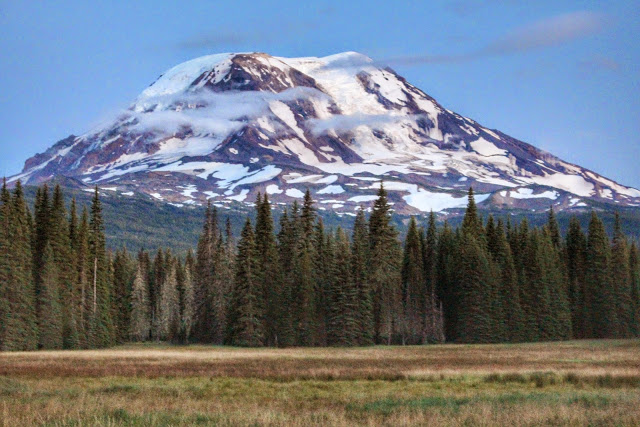Trip Report: Mt. Adams, WA
Posted by Heather K. on Jul 1st 2015

This June, I had the opportunity to go on my first ever mountaineering excursion. The hill? Mt. Adams, a nearly 12,500′ peak in Washington State’s Cascade Range. Mt. Adams is the largest active volcano in the Cascades, although its last eruption was over 3,800 years ago. On a clear day, Mt. Hood, Mt. Rainier, and Mt. Saint Helens are all visible from the summit. As far as “first peaks” go, I picked a mighty good one.
Before I even bought my plane tickets, I had to meticulously research and plan the trip, making sure that my gear was appropriate for whatever the summit could throw at me. Since this was my first ever mountaineering trip, I shamelessly over-studied. Back from the trip in one piece, I’d like to share my knowledge with you and hopefully save you some time on your next ascent!
The summit field and volcanic cone of Mt. Adams, WA.
First things first, you need the right paperwork to even attempt a summit: in order to hike Mt. Adams, we needed a Cascade Volcano Pass. A Cascade Volcano Pass is required to hike the Mt. Adams wilderness above 7,000ft, and therefore a necessity for any would-be summit missions. They’re available by mail or the ranger station and they cost $15 for a weekend pass, $10 for a weekday pass, and $30 for a yearly pass.
Mt. Hood (left) visible from the Mt. Adams summit
My friend and I were planning on a single-day summit along the “South Climb” (non-technical) trail. The South Climb trailhead is located at the Cold Springs Campground, at the end of a long and winding dirt road. Since early summer is peak season for the area, the trailhead was packed with cars and people. Seasoned Mt. Adams hikers were even prepping skis so they could hike up, then ski back down! The Forest Service estimates 6-8hrs for ascent and 4-6hrs for descent along the South Climb, and that was without the peak season crowds that would undoubtedly jam the trail. Basically, we had to hit the ground running (and early) and not be held back by our gear.
I hiked with the Deuter ACT 28 SL Backpack stuffed with a 2L hydration bladder. The pack was able to accommodate crampons, rain gear, a fleece, my shell, snack bars, and two other Nalgenes – everything I needed for South Climb and perfect for a long day hike. I attached my helmet, ice axe, and trekking poles to the outside using the pack’s plentiful straps and gear loops. I rented the crampons, helmet, and trekking poles from Outdoor Research in Seattle, WA to avoid hauling them on the plane. The staff was friendly and very helpful! I highly recommend them for rental gear.
Mt. Adams can be extraordinarily hot once you get high enough. I over packed layers and jackets because I was expecting it, a 12,000′ foot snowcap, to be cold and windy. While I could have done without most of my other layers once I got moving, it was good to be prepared. Were anything to happen on the ascent that prevented us from making our one-day summit, the layers could have saved my life. I wore an Icebreaker CoolLite tank with the Arcteryx Atom LT over it for most of the hike. The combination of the two helped keep me cool and dry once in motion, but also warm when I needed it (for example, for a 5am start at 5,600′). There were times I unzipped the Atom to get a breeze, but didn’t want to take it off – the Arc’teryx jacket functioned exactly as I needed it to and provided awesome body temperature regulation (due to thick insulation in the front, back and arms and breathable paneling on the sides). It was the perfect mid-layer for the day.
When I say “snowy sections”, I really mean it! Mt. St. Helens visible in background.
Good sunglasses or ski goggles also make a huge difference. I had my pair of Native ITSO sunglasses on from first light, and the definitely saved me from glare and eye-strain once I hit the snowy sections near the top. The Natives were lightweight, protected my eyes from the sun, and encountered no glare. I also didn’t get the fishbowl effect. They fogged up a few times due to how hot it was, but that’s borderline unpreventable. Although I packed both, my sunglasses worked so well I didn’t even have to unpack the goggles!
If you’re interested in mountaineering and looking for a good place to start, check out Mt. Adams! It’s the right mix of newbie-friendly and challenging, with a spectacular view once you make it to the summit.
~Heather K. -Women’s Technical Apparel
Planning a trip? Want to get more insider tips and travel recommendations from Bivouac’s expert staff? Read about our adventures to Canyonlands National Park (UT), Pictured Rocks National Lakeshore (MI), and Chicago (IL), or click here to go back to the Bivouac Blog!



